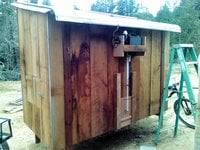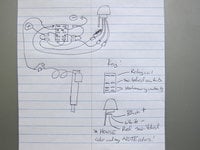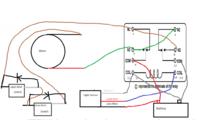totalloser
In the Brooder
- Mar 14, 2018
- 11
- 15
- 24
I looked at a lot of door designs, and though this may have been done before, this is how I did it, and think it's worthy of consideration. 
My experience is that timers are close to useless as far as reliability, so I chose to use a photoswitch to operate a small 12v DPDT (dual pole dual transfer) relay which reverses the polarity on a linear actuator. The linear actuator has built in limit switches (I "think" most do) so the installation is fairly simple, and durable.
One bummer is that almost all photoswitches are designed for streetlights, so they are "on" at night, and thus the relay is live all night. However, the switch and relay draw very little juice. I am using a 12v solar with a puny mppt controller, but there are plenty of other ways to make this work.
Also of note: since the photoswitch is "on" at night, this enables a 12v LED motion light so it doesn't run all day for chicken antics.
Photoswitch $10 Relay $5 Linear actuator $25 Other stuff can be done other ways, but I will note that the battery would be the costly part, and your *old* car battery with a foot in the grave is more than adequate to run these puny loads.
Oh, and the astute viewer will note that it's not completely hooked up. That's just because it was the pic I had handy.

My experience is that timers are close to useless as far as reliability, so I chose to use a photoswitch to operate a small 12v DPDT (dual pole dual transfer) relay which reverses the polarity on a linear actuator. The linear actuator has built in limit switches (I "think" most do) so the installation is fairly simple, and durable.
One bummer is that almost all photoswitches are designed for streetlights, so they are "on" at night, and thus the relay is live all night. However, the switch and relay draw very little juice. I am using a 12v solar with a puny mppt controller, but there are plenty of other ways to make this work.
Also of note: since the photoswitch is "on" at night, this enables a 12v LED motion light so it doesn't run all day for chicken antics.
Photoswitch $10 Relay $5 Linear actuator $25 Other stuff can be done other ways, but I will note that the battery would be the costly part, and your *old* car battery with a foot in the grave is more than adequate to run these puny loads.
Oh, and the astute viewer will note that it's not completely hooked up. That's just because it was the pic I had handy.
Attachments
Last edited:













